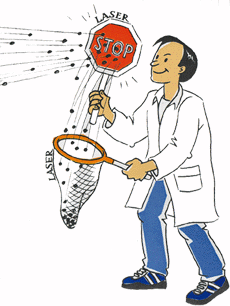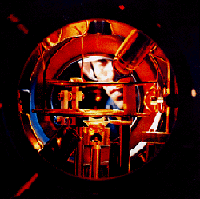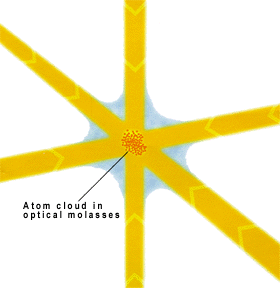Deceleration of Atoms
 |
Light acts mechanically on material objects, which means it can change their positions and velocities. This mechanical action of light is used in laser cooling and trapping to reduce the velocity spread for a collection of atoms (cooling), or to confine the atoms in a small volume (trapping). A breakthrough was achieved in the early 1980s when William Phillips developed new methods of decelerating a fast atom beam. In 1985 the first reports came from experiments where the mean velocity had been reduced from 1000 m/s to zero. |
|
To achieve trapping, the light must induce a position-dependent force on the atoms (in contrast to cooling which requires a velocity-dependent force). Different types of atom trap have been designed. The most often used is the Magneto-Optical Trap (MOT). In a MOT, trapping is accomplished with three pairs of counter-propagating laser beams and an inhomogeneous magnetic field. |
 |
 |
A collection of sodium atoms (yellow dot in middle of picture) trapped in a MOT. |
|
The next breakthrough came in the same year when Steven Chu cooled atoms in three dimensions, using Doppler cooling with three pairs of counter-propagating laser beams. In this configuration an atom, regardless of what direction it is moving, will encounter a friction force. In this way the velocity spread (and the temperature) will be reduced. The action of the laser light on the atoms is like that of a sticky medium, giving rise to the term optical molasses. |
|
| Optical molasses. In the area where the six laser beams intersect, the atoms move slowly as in a sticky medium. |
Nobel Prizes and laureates
See them all presented here.
